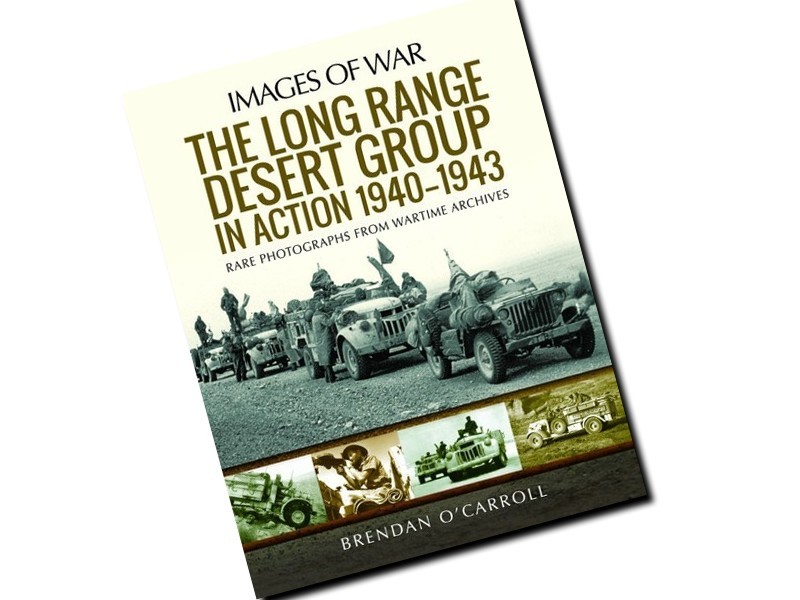
Introduction
The following introduction is as provided by Pen and Sword:
The Long Range Desert Group has a strong claim to the first Special Forces unit in the British Army. This superb illustrated history follows the LRDG from its July 1940 formation as the Long Range Patrol in North Africa, tasked with intelligence gathering, mapping and reconnaissance deep behind enemy lines. Manned initially by New Zealanders, in1940 the unit became the LRDG with members drawn from British Guards and Yeomanry regiments and Rhodesians.
So successful were the LRDG patrols, that when the Special Air Service were formed, they often relied on their navigational and tactical skills to achieve their missions. After victory in North Africa the LRDG re-located to Lebanon before being sent on the ill-fated mission to the Dodecanese Islands in the Aegean. Serving independently, when the Germans overwhelmed and captured the British garrisons, many LRDG personnel escaped using their well-honed skills.
Many images in this, the first pictorial history of the LRDG, were taken unofficially by serving members. The result is a superb record of the LRDG’s achievements, the personalities, their weapons and vehicles which will delight laymen and specialists alike.
Some information on the author:
Brendan O’Carroll lives in Auckland, New Zealand and recently retired from the New Zealand Customs Service. With a long time interest in military history, the Long Range Desert Group has become his speciality. He has interviewed over 30 veterans while writing The Kiwi Scorpions: The Story of the New Zealanders in the LRDG (2000), Bearded Brigands(2002) and Barce Raid: The LRDG’s Most Daring Exploit in World War Two (2005).This book follows The LRDG in the Aegean (2020) under the Pen and Sword Military imprint. He has numerous other published works and articles to hiscredit. In 2006 his work was recognised by awards from the New Zealand Military Historical Society.
Review
This offering from Pen and Sword is part of the ‘Images at War’ series. This series of books are soft backed offerings having a good card cover with a very good spine to the book that keeps the contents in good order. This book covering ‘The Long Range Desert Group in Action 1940-1943’ has been authored by Brendan O’Carroll. The contents of this title are provided over 215 pages of good quality semi gloss paper plus a good number of blank pages at the rear of the title for the reader to make notes.
The contents are presented in the following sections:
Acknowledgements
Introduction
Chapter 1 – The Early Days
Chapter 2 – Long Range Desert Group Operations in the Fezzan, 1941
Chapter 3 – 1941-42: An Overview – The CMP Ford F30
Chapter 4 – 1942-43: An Overview – Chevrolet 1533X2 4 X 230cwt
Chapter 5 – The Long Range Desert Group Air Section
Chapter 6 – The Barce Raid
Chapter 7 – The Final Days in the Desert
Chapter 8 – The Dodecanese Operations: The Aegean, 1943
This offering from Pen and Sword is part of the Images of War series and is laid and logical manner. The author has provided a written introduction to each section which offers varying degrees of information to the reader. The format for this series of books does I feel make it difficult for the author to provide the level of information that they wish to, but I would class the efforts of the author here as especially good and provides excellent information on the main vehicles used and two of the major operations undertaken.
The introduction and early days of the unit that became the LRDG are well worth the read and provides some excellent visual reference. The quality of some images is also addressed here and it us explained that while personal cameras were not permitted the men of the LRDG were not ones for following the rules of others and had their own code. The picture quality is the result of general equipment quality, the conditions cameras and film were exposed to and the locations in which the film was developed.
The chapters covering the CMP Ford F30 and Chevrolet 1533X24 X 2 30cwt trucks are chapters that I found particularly appealing from both the written and pictorial aspects. The written information provides some great snippets such as how many of the crews hated the CMP Ford F30 trucks due to the engines protruding into the cab and make the heat even more unbearable. Due to this section being on the vehicles it also provides some great visual reference on the changes the crews made to make the vehicles more effective and reliable.
The book also covers a couple of the Operations the units were involved in; one of which was Dodecanese Operations that cost the LRDG so many of its highly trained members. The photographs do a great job of covering the wide range of uniform and clothing worn by the members of the LRDG. The uniform worn was both official, civilian and native produced such as the goat/sheepskin jackets that were so praised; many think of the heat in the desert but it’s the cold at night that can be just as deadly.
Conclusion
This offering from Pen and Sword is part of the Images of War series is the most appealing I have obtained so far due to the presentation and subject matter. The text is well written and I enjoyed reading it and in doing so learned bits I didn’t know previously. The photographs brought together here are a stunning selection despite the various quality as it shows the men and machines living the war they fought in, it also puts the reader in touch with these men none of whom I could find alive today. Lastly the captions are well written and provide that extra touch that photographs benefit from.



























